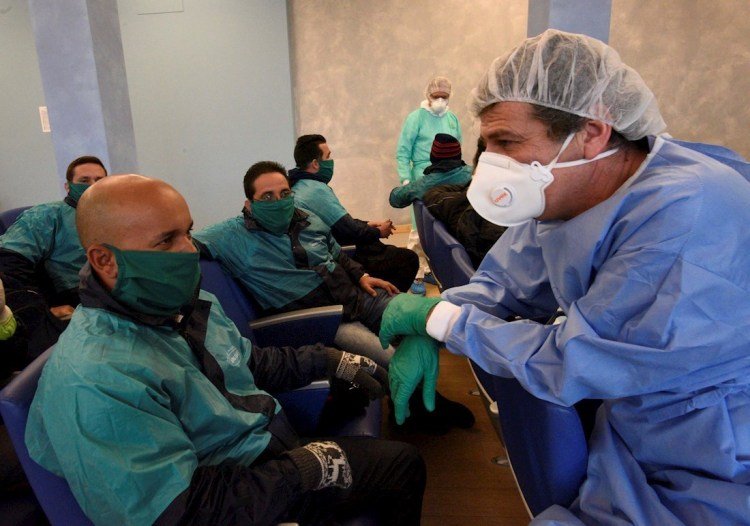The Italian region of Lombardy, one of the most affected by the coronavirus, has recruited 53 Cuban doctors and nurses, while medical brigades from the island have also started arriving in other countries in the Americas, the Caribbean, and even Africa.
What makes them so valuable in this type of scenario?
How does public health work in Cuba and why are there so many doctors?
The training of doctors and health personnel for decades has been one of the priorities in Cuba, where both the healthcare system and education and university studies are public and free.
The system that has been in force on the island for 60 years does not allow doctors to work in the private sector: they all do it for the State. In the country there are nine doctors for every 1,000 inhabitants, according to official data from 2019.
The “army in white coats”: going where no one wants to go
The “medical missions,” as they are called in Cuba, consist of sending health professionals to countries that request it from the Cuban government.
These requests come in the event of a crisis, as has happened now with Italy, but they are usually made by nations that need more doctors than they have, that want to reinforce specific medical specialties or that need to cover healthcare in remote or risky areas. to which the local doctors don’t want to go.
There are currently some 28,000 Cuban doctors in 59 countries, of which 37 have cases of COVID-19. Over the years, more than 400,000 professionals have completed missions in 164 countries in Africa, the Americas, the Middle East, and Asia.
How much does a Cuban doctor cost and who pays for it?
Although in some cases―especially humanitarian catastrophes―they are solidarity initiatives whose cost is borne by the State, most of the missions fall into the category of export of professional services, one of Cuba’s main sources of foreign currency.
The country that contracts these services pays for them to the Cuban government, which does not disclose specific details of the transactions. The latest official data available (2017) placed Cuba’s income from professional services at 9.628 billion dollars.
The salary that an applicant country pays for each Cuban professional varies, but workers receive only a percentage of that money―it is estimated that between 20 and 30%. The rest goes to the coffers of the Cuban State, which ensures that these revenues are used to finance the free healthcare system on the island.
https://oncubanews.com/mundo/africa/brigada-medica-cubana-llegara-a-angola-para-apoyar-lucha-contra-el-coronavirus/
Why are they good at managing health crises?
In 2005, then-Cuban President Fidel Castro ordered the creation of an emergency medical contingent to offer assistance to the United States after the Hurricane Katrina disaster in New Orleans.
The neighboring country rejected the aid, but the Henry Reeve brigade had already been born. Until now it has assisted in the front line in countless crises and disasters: the Ebola epidemic in Sierra Leone, Guinea (Conakry) and Liberia (2014-2015) and that of cholera in Haiti, the earthquakes in that Caribbean country, Pakistan (2005) and Nepal (2015), floods and hurricanes in Central America and the Caribbean….
The experience accumulated in these three decades makes them extremely valuable in medical emergencies and was recognized in 2017 by the World Health Organization with the award for Public Health in Memory of Dr. Lee Jong-wook.
Necessity is the mother of invention
To all the wealth of experience accumulated by the Henry Reeve brigade is added the response capacity of the Cubans, who after 60 years under U.S. embargo and with an inefficient planned economy, are used to facing difficult situations with limited resources.
From putting a broken limb in a splint made with wood from a door frame to using a plastic cup as a nebulizer, Cuban doctors have a proven track record of reacting quickly and finding solutions given their country’s perpetual shortage.
Which countries have asked for Cuban doctors to fight the coronavirus?
In addition to the 53 doctors and nurses who are already in the Italian region of Lombardy, in the last two weeks brigades of doctors and nurses have left for Angola, Grenada, Suriname, Jamaica, Belize, Antigua and Barbuda, Saint Vincent and the Grenadines, Dominica and Saint Lucia.
Six specialists from the Henry Reeve brigade traveled to Venezuela, where more than 20,000 Cuban doctors work, and another five from that same contingent traveled to Nicaragua to collaborate with that country in the implementation of control protocols, confrontation and treatment of the COVID-19.
In the coming days, new brigades are slated to leave for other nations. The specialties most demanded by the countries are intensive therapy, virology, epidemiology and pharmacology, according to reports from the state press.
The controversy with the United States
Cuban medical missions, however, have also recently become a battlefront between the island and the United States, which this week urged countries that are requesting medical aid from Havana to examine the agreements and put an end “to labor abuses.”
Months ago the United States launched a campaign of attacks against the medical services of the Caribbean country, whose government it accuses of withholding most of the salary of health personnel while exposing them to “appalling working conditions.”
Cuba protesta por acusaciones de EEUU a sus misiones médicas
Cuba calls these accusations “lies” and an “immoral campaign,” and has asked to put aside “pettiness and hostility” in the midst of the COVID-19 pandemic that has already claimed thousands of victims in just three months.
In the last year, the island also withdrew, due to political clashes, thousands of doctors from its missions in Brazil, Ecuador and Bolivia.
Aside from working conditions, human rights organizations critical of the Cuban government have also considered in recent days that medical missions are used as propaganda.










